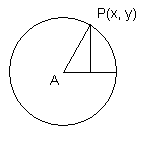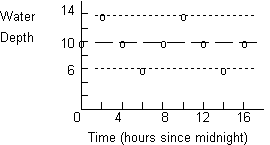Periodic Functions
In earlier math classes you have dealt with functions. None of those functions were periodic in nature in that they did not repeat the same set of values time after time. Here, for the first time, we will begin to discuss functions that repeat, they are called Periodic Functions.
 To start with let us put our triangles from the first lesson inside of circles. This doesn't hurt anyone and it will help if you read a textbook and it talks about circular functions. The figure at the right shows a triangle inside a circle. We have generated the angle A by starting with a line along the positive x axis (to the right of the origin) and rotating it counterclockwise. When we laid the line along the x axis we defined the INITIAL side of the angle A. The line that goes from the origin to the point P(x, y) is called the TERMINAL side of the angle A. The angle A is between its inital side and its teminal side. Although it may seem strange angles generated by counterclockwise rotations are positive and angles generated by clockwise rotation are negative.
To start with let us put our triangles from the first lesson inside of circles. This doesn't hurt anyone and it will help if you read a textbook and it talks about circular functions. The figure at the right shows a triangle inside a circle. We have generated the angle A by starting with a line along the positive x axis (to the right of the origin) and rotating it counterclockwise. When we laid the line along the x axis we defined the INITIAL side of the angle A. The line that goes from the origin to the point P(x, y) is called the TERMINAL side of the angle A. The angle A is between its inital side and its teminal side. Although it may seem strange angles generated by counterclockwise rotations are positive and angles generated by clockwise rotation are negative.
 If we continue around the circle we can generate a series of values for angle A. Three such values are shown in the figure on the right. In each case where the terminal side of the angle touches the circumference of the circle we have labeled the point P with coordinates, x and y. If we were to go around the circle a second time we could generate exactly the same points. As a matter of fact if we were to continuously go around the circle we would be able to generate the same points revolution after revolution. Our function is periodic it repeats itself every rotation. In the case of a circle if you add 360o to the value of any angle you will come back to exactly the same positon. Your text (Connally) tells you that a periodic function is one where f(t + c) = f(t). In the case we have been describing c is 360o. The example in the book uses a ferris wheel to illustrate the point. Let's look at the same type of motion in another context.
If we continue around the circle we can generate a series of values for angle A. Three such values are shown in the figure on the right. In each case where the terminal side of the angle touches the circumference of the circle we have labeled the point P with coordinates, x and y. If we were to go around the circle a second time we could generate exactly the same points. As a matter of fact if we were to continuously go around the circle we would be able to generate the same points revolution after revolution. Our function is periodic it repeats itself every rotation. In the case of a circle if you add 360o to the value of any angle you will come back to exactly the same positon. Your text (Connally) tells you that a periodic function is one where f(t + c) = f(t). In the case we have been describing c is 360o. The example in the book uses a ferris wheel to illustrate the point. Let's look at the same type of motion in another context.
 Suppose we have just moved to a new planet where the tides go up and down over an 8 hour time cycle. Starting at midnight the water by us is 10 feet deep. At 2 AM the water is 14 feet deep, at 4 AM 10 feet again, at 6 AM 6 feet and at 8 AM it is back at 10 feet. If we continue to track the depth of the water it follows this cycle time after time. The graph at the right shows two tidal cycles but no matter how many cycles we followed the same pattern would repeat itself. This is a periodic function.
Suppose we have just moved to a new planet where the tides go up and down over an 8 hour time cycle. Starting at midnight the water by us is 10 feet deep. At 2 AM the water is 14 feet deep, at 4 AM 10 feet again, at 6 AM 6 feet and at 8 AM it is back at 10 feet. If we continue to track the depth of the water it follows this cycle time after time. The graph at the right shows two tidal cycles but no matter how many cycles we followed the same pattern would repeat itself. This is a periodic function.
There are three characteristics of periodic functions that we should note:
- They possess a period, usually measured along the x axis. In this case the period of our function is 8 hours.
- They have a midline, the center line that they vary below and above. The midline here is 10 (feet in this case).
- They have an amplitude. The distance above and below the midline. In the this case it is 4 (again feet). Even if we lifted the entire curve by adding 50 to every value the amplitude would still be 4. The amplitude depends on how far above and below the midline the curve goes, not on the absolute height of the curve.
 To start with let us put our triangles from the first lesson inside of circles. This doesn't hurt anyone and it will help if you read a textbook and it talks about circular functions. The figure at the right shows a triangle inside a circle. We have generated the angle A by starting with a line along the positive x axis (to the right of the origin) and rotating it counterclockwise. When we laid the line along the x axis we defined the INITIAL side of the angle A. The line that goes from the origin to the point P(x, y) is called the TERMINAL side of the angle A. The angle A is between its inital side and its teminal side. Although it may seem strange angles generated by counterclockwise rotations are positive and angles generated by clockwise rotation are negative.
To start with let us put our triangles from the first lesson inside of circles. This doesn't hurt anyone and it will help if you read a textbook and it talks about circular functions. The figure at the right shows a triangle inside a circle. We have generated the angle A by starting with a line along the positive x axis (to the right of the origin) and rotating it counterclockwise. When we laid the line along the x axis we defined the INITIAL side of the angle A. The line that goes from the origin to the point P(x, y) is called the TERMINAL side of the angle A. The angle A is between its inital side and its teminal side. Although it may seem strange angles generated by counterclockwise rotations are positive and angles generated by clockwise rotation are negative.
 If we continue around the circle we can generate a series of values for angle A. Three such values are shown in the figure on the right. In each case where the terminal side of the angle touches the circumference of the circle we have labeled the point P with coordinates, x and y. If we were to go around the circle a second time we could generate exactly the same points. As a matter of fact if we were to continuously go around the circle we would be able to generate the same points revolution after revolution. Our function is periodic it repeats itself every rotation. In the case of a circle if you add 360o to the value of any angle you will come back to exactly the same positon. Your text (Connally) tells you that a periodic function is one where f(t + c) = f(t). In the case we have been describing c is 360o. The example in the book uses a ferris wheel to illustrate the point. Let's look at the same type of motion in another context.
If we continue around the circle we can generate a series of values for angle A. Three such values are shown in the figure on the right. In each case where the terminal side of the angle touches the circumference of the circle we have labeled the point P with coordinates, x and y. If we were to go around the circle a second time we could generate exactly the same points. As a matter of fact if we were to continuously go around the circle we would be able to generate the same points revolution after revolution. Our function is periodic it repeats itself every rotation. In the case of a circle if you add 360o to the value of any angle you will come back to exactly the same positon. Your text (Connally) tells you that a periodic function is one where f(t + c) = f(t). In the case we have been describing c is 360o. The example in the book uses a ferris wheel to illustrate the point. Let's look at the same type of motion in another context.
 Suppose we have just moved to a new planet where the tides go up and down over an 8 hour time cycle. Starting at midnight the water by us is 10 feet deep. At 2 AM the water is 14 feet deep, at 4 AM 10 feet again, at 6 AM 6 feet and at 8 AM it is back at 10 feet. If we continue to track the depth of the water it follows this cycle time after time. The graph at the right shows two tidal cycles but no matter how many cycles we followed the same pattern would repeat itself. This is a periodic function.
Suppose we have just moved to a new planet where the tides go up and down over an 8 hour time cycle. Starting at midnight the water by us is 10 feet deep. At 2 AM the water is 14 feet deep, at 4 AM 10 feet again, at 6 AM 6 feet and at 8 AM it is back at 10 feet. If we continue to track the depth of the water it follows this cycle time after time. The graph at the right shows two tidal cycles but no matter how many cycles we followed the same pattern would repeat itself. This is a periodic function.